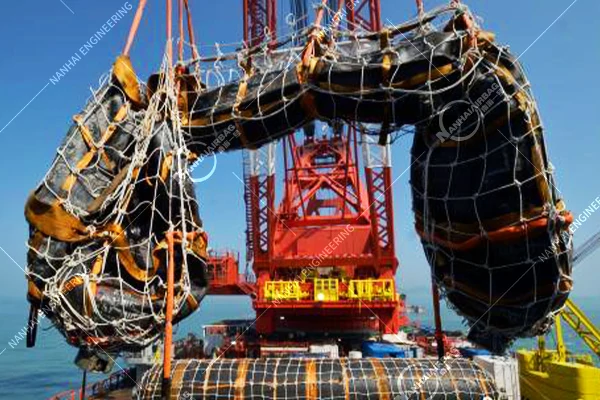Performance of Pneumatic Fenders in Extreme Cold Environments
07/07/2025Are Cell Fenders Worth the Investment?
07/08/2025How to Lift a Sunken Vessel Using Marine Salvage Airbags
How NANHAI Lifts Sunken Vessels Using Marine Salvage Airbags
Lifting a sunken vessel requires careful planning and execution. At NANHAI, we specialize in marine salvage operations, and one of our most effective methods involves using marine salvage airbags. These inflatable buoyancy units, also known as pontoon airbags or heavy-duty lifting bags, provide significant lifting power and flexibility for various salvage scenarios. Our rugged salvage bladders are engineered to fully comply with ISO 14409 standards to provide reliability in demanding underwater environments.

Here’s a detailed, step-by-step guide on how NANHAI lifts sunken vessels using marine salvage airbags:
Step 1: Pre-Salvage Assessment and Planning
Before any physical work begins, a thorough assessment is crucial for a successful salvage operation.
- Site Survey and Damage Assessment: Our team first conducts a comprehensive survey of the sunken vessel and its surrounding environment. This includes:
- Determining the vessel’s exact location, depth, and orientation on the seabed.
- Assessing the extent of damage to the hull and superstructure.
- Analyzing the seabed conditions (e.g., mud, sand, rock) and potential obstructions.
- Evaluating tidal patterns, currents, and weather forecasts for the duration of the salvage.
- Salvage Plan Development: Based on the assessment, NANHAI’s engineers develop a detailed salvage plan. This plan outlines:
- The type, size, and number of marine salvage airbags required. We select the appropriate lifting bags based on the vessel’s weight and configuration.
- The optimal placement of the airbags is to achieve a stable and controlled lift.
- Calculation of the required buoyancy to overcome the vessel’s submerged weight and any additional resistance (e.g., suction from the seabed). Our inflatable buoyancy units are designed to provide precise lift.
- Selection of appropriate lifting equipment (e.g., winches, cranes) if needed in conjunction with the airbags.
- Safety protocols and emergency procedures for the salvage effort.
- Environmental considerations and measures to prevent pollution during the salvage.
Step 2: Site Preparation and Divers’ Work
Once the plan is finalized, our dive teams prepare the vessel and the site for the salvage.
- Establishing a Work Platform: If necessary, a work platform or salvage barge is positioned near the sunken vessel to serve as a base for operations, holding equipment, and providing support for divers.
- Debris Clearance: Divers clear any debris around or on the vessel that could hinder airbag placement or snag during the lift.
- Vessel Inspection and Securing Points: Divers conduct a close-up inspection of the vessel’s hull to identify suitable attachment points for the salvage airbags. These points must be structurally sound to withstand the immense lifting forces generated by the airbags. Reinforcements may be added if necessary.
- Rigging and Attachment: Our divers meticulously rig the marine salvage airbags to the designated attachment points on the vessel. This involves:
- Passing strong straps or chains through the integrated D-rings or slings on the airbags.
- Securing these straps or chains to strong points on the vessel, such as bollards, cleats, or specially prepared padeyes. The method of attachment is critical to ensure the inflatable buoyancy units remain securely in place during inflation and the lift.
Step 3: Salvage Airbag Inflation and Controlled Lift
This is the core phase of the salvage operation, requiring precise control over the airbags.
- Air Supply Connection: Air hoses from high-pressure compressors on the surface (either on a salvage vessel or shore-based) are connected to the inflation valves of the marine salvage airbags.
- Controlled Inflation: Air is slowly and incrementally introduced into the airbags. This process is carefully monitored by NANHAI’s salvage masters, who receive real-time data from pressure gauges and depth sensors.
- Even Buoyancy Distribution: Inflation is typically done in stages, often inflating multiple lifting bags simultaneously to ensure an even distribution of buoyancy and prevent uncontrolled tilting or capsizing of the vessel.
- Monitoring and Adjustment: Divers continuously monitor the airbags‘ performance and the vessel’s movement, making adjustments as needed. This often involves fine-tuning the air pressure in individual salvage airbags to maintain stability and control the vessel’s ascent rate.
- Gradual Ascent: As the inflatable buoyancy units fill with air, they displace water, generating upward force. The vessel gradually becomes buoyant and begins to lift off the seabed. The rate of ascent is controlled to prevent sudden movements that could cause further damage to the vessel or equipment during this critical salvage phase.
- Surface Ballasting (if needed): Once the vessel approaches the surface, NANHAI may partially de-ballast internal tanks on the sunken vessel to assist in stability and control the final emergence, supported by the salvage airbags.
Step 4: Towing and Recovery
After the vessel is successfully refloated, the final steps involve securing and recovering it.
- Stabilization: Once on the surface, the vessel is stabilized, often by adjusting the air in the airbags or by pumping out any remaining water from accessible compartments.
- Towing: The refloated vessel, often still supported by the salvage airbags, is then carefully towed to a safe harbor, dry dock, or designated repair facility. The inflatable buoyancy units may remain attached to provide continued buoyancy and stability during transit.
- Deflation and Removal: Once the vessel is secured at its destination, the marine salvage airbags are deflated and carefully removed, cleaned, inspected, and prepared for future salvage use.
NANHAI’s expertise in using marine salvage airbags allows us to conduct efficient, safe, and environmentally responsible salvage operations, minimizing further damage to the sunken vessel and ensuring its successful recovery. Our airbags are a vital tool in complex underwater salvage projects.
